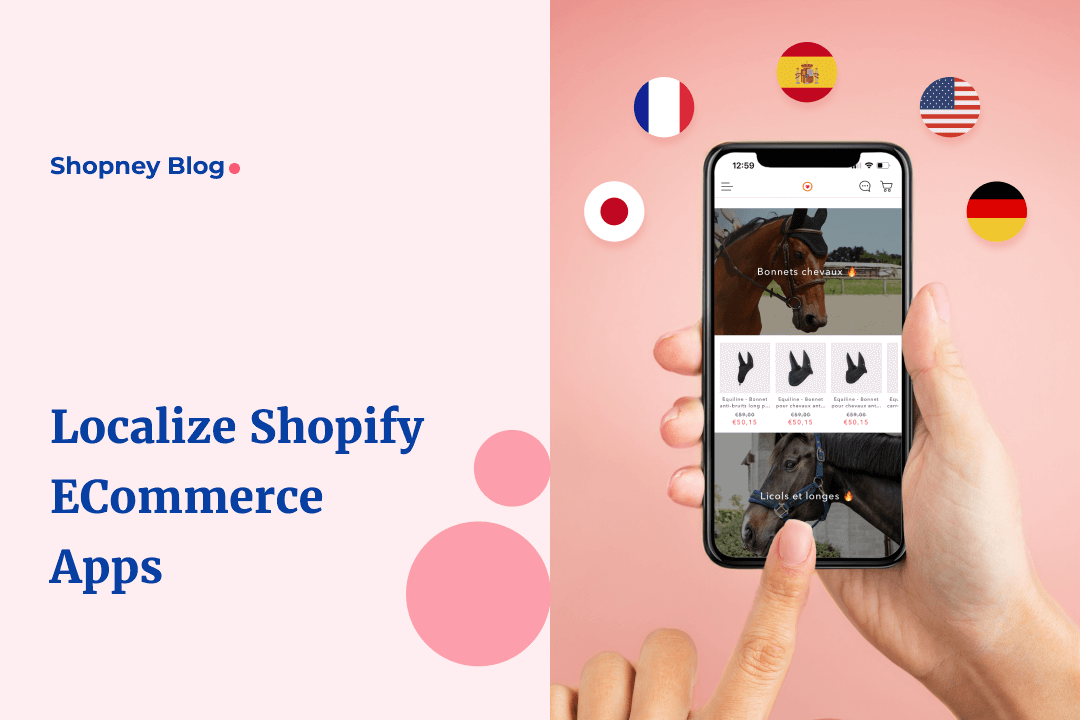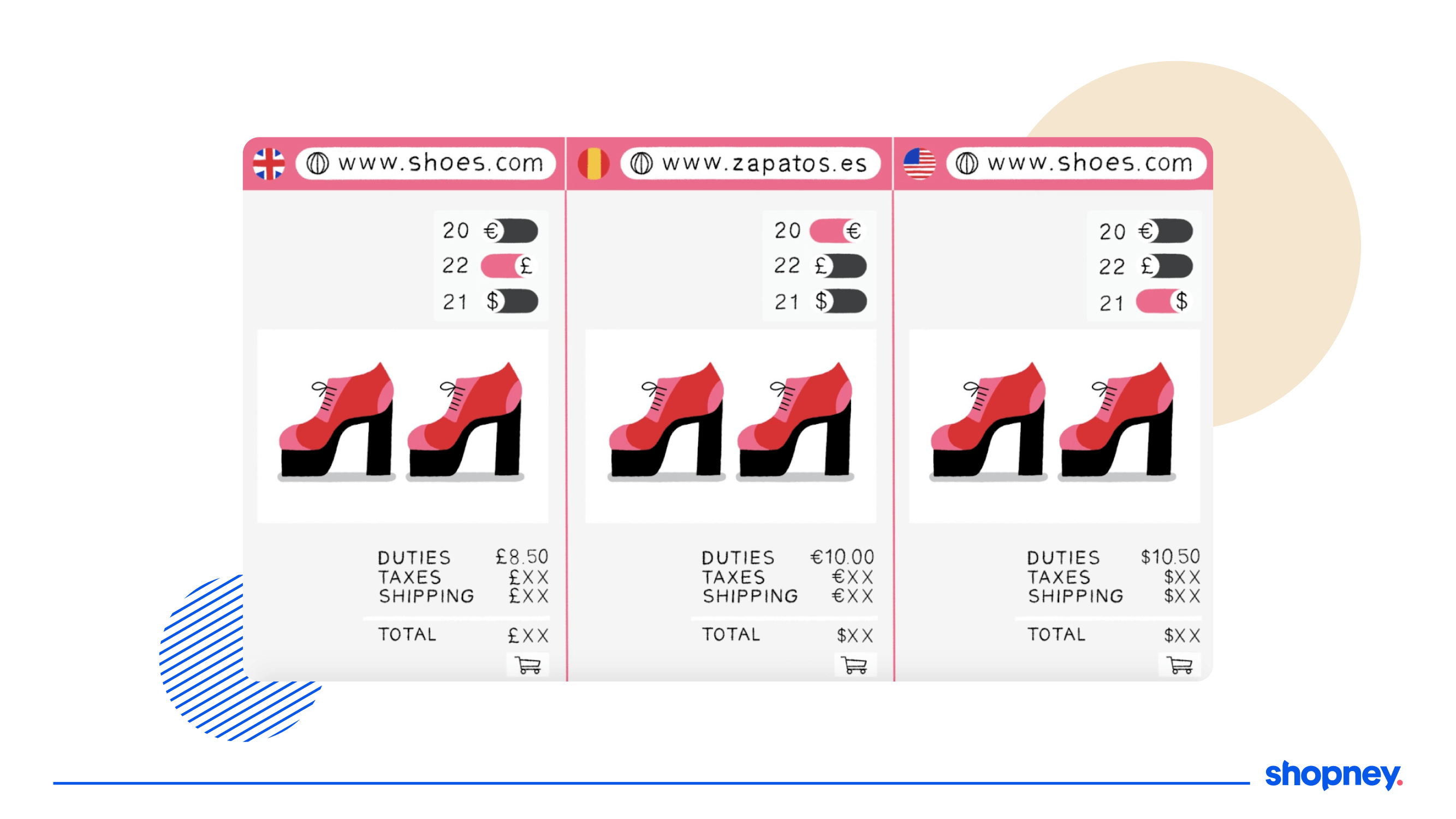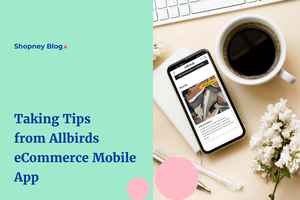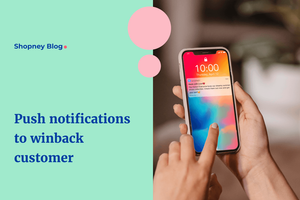
Check out our complete guide to localization for Shopify eCommerce apps to expand quickly and seamlessly in new markets.
Do you think that if you’re not in the US, someone exploring your eCommerce app will find a trending catalog section made for SuperBowl inspired merchandise as intriguing?
Will a user in China glance and skim across your app screens according to how their language is read, that is from left to right, or react to your chosen color scheme as you would?
Nope!
This is where localization for eCommerce apps comes in.
With online shopping becoming increasingly popular, your customers now expect not just convenience but also a personalized, ‘local’ experience.
In fact, a study found that 55% of international consumers will only buy from stores that provide product information in their own language, and 72% of shoppers are more likely to buy from sites written in their native language.
In 2023, it has become one of the most important ways to expand and conquer new markets.
In today’s blog post, we’re going to equip you with a solid understanding of what you need to remember and implement if you want to localize your app to scale globally.
And we’re going to make it as jargon-free as possible - so you don’t get overwhelmed!
What does Localization for eCommerce Apps Mean?
Localization is much more than simple translation - it refers to the process of tailoring an app's user interface and functionality to accommodate and delight users in different target markets.
Besides translating the textual content of your e-commerce app, you also need to refine all your assets, such as UI elements, specific features, in-app copy, graphics, and app store descriptions, to the cultural preferences, habits, and expectations of the target market.
Every language or accent has its nuances, and you can capitalize on them to personalize your user experience.
This would be similar to Shopify store localization, but the changes are reflected in your eCommerce mobile app.

Source
Why is Shopify eCommerce app Localization Important?
Research shows that users prefer content in their own language- you can lose up to 8-13% of your users if you don’t localize.
By localizing your app, you can target users in every country, expanding your app's exposure and coverage.
Investing in localization can dramatically increase your market share and revenue streams in each new country you enter, and if you include this in your consideration and planning before your app is even launched - you’ll be able to quickly and efficiently launch in multiple markets.
Types of Localization for eCommerce Apps
There are two primary types: Minimum viable localization (MVL) and Full app localization.
1. Minimum viable localization (MVL)
MVL is ideal for early-stage app startups. It prioritizes a fast time to market by localizing only the app’s key features, app store descriptions, and app store metadata.
2. Full app localization
This includes adapting every element of the app. If you want to be a global company committed to maximizing your app’s reach, user base, and revenue opportunities, we would recommend you to consider this method.

How to Localize Your Shopify eCommerce Mobile App?
While you may choose to approach mobile app localization differently, we do recommend covering the steps below:
Step 1: Study your Target Market
Conduct market research to understand your potential customers' preferences and interests and identify popular localized apps in your target market.
Deeply examine your competitor apps - by studying layouts, designs, and customer reviews, you can gain insights into the pros and cons of their localization strategies.
Remember to find out which languages are available for translation on platforms like the App Store and Google Play!
Step 2: Choose a Method of Mobile App Localization
There are three main methods you should consider:
- Mobile Software Development Kit (SDK) with a Translation Service Provider Want a seamless translation of your content without requiring resubmission of the app? Use this method! SDKs are downloadable nuggets that contain all the tools needed to build mobile apps and a translation service provider can use its text strings to add new translations anytime.
- API & Connector Integrations with Translation Service Provider This method involves using a communication system that "talks" to translation services. It's like asking them to translate any new content in your app and once the translation is done, you get a notification, after which you can then add it to your app. Or, you can periodically check if any translation task is finished and add it when ready.
- Manual + Translation Service Provider In this method of mobile app localization, your translation service provider will translate the content for you, and then you need to manually add it to your app. It's straightforward but can be time-consuming as it involves manually updating your app and can cause delays.
Step 3: Select a Translation Service Provider
Google Translate isn’t enough- if you were considering it to cut costs. An important part of translation is to ensure it’s not just literal - but incorporates local semantics, pop culture references, and more.
You can also consider automated translation services, and ensure that all new content is updated automatically.
The approach to localization management can be file-based or follow a continuous process, depending on the level of control you want over the process - and we recommend the latter, especially if you want to scale into multiple markets.
Step 4: App Store Optimization (ASO) and Launch
App Store Optimization (ASO) plays a vital role in ensuring your app's visibility and download rates. It involves optimizing app titles, keywords, screenshots, and descriptions. With a global app, ASO must be executed separately for each language, requiring research to identify popular search terms in each target language.
Ensuring your app meets the recommendations for product pages and preview assets for platforms like the Apple App Store and Google Play Store is also crucial.
Step 5: Provide Customer Support to all Markets
It's important to ensure that all new markets are supported and that users in every region have access to assistance when needed. Don’t forget to translate support content and help guides, and provide multilingual customer service.

Challenges in Shopify eCommerce mobile app Localization
Unforeseen delays, additional costs, and quality issues detected at app release can all slow you down.
However, these challenges can be managed by ensuring localization preparation from the start, verifying app localization quality before release, and integrating app localization and app development into a single workflow so they are executed parallelly and seamlessly!
To help you navigate this, take a look at our next section where we’ve covered best practices, tips, and strategies for eCommerce mobile app localization that will have you primed for success from the start!
Best Practices for Shopify eCommerce Mobile apps
Localization of eCommerce mobile apps can be done in many ways. But let’s look at some best practices we recommend following:
1. Practice Early Internationalization
Internationalization is the process of designing and building an app to be adaptable to various languages and regions without requiring changes to its core programming or structure. Make sure that your app’s core functions can support multiple languages, number formats, date formats, and cultural conventions. This makes the subsequent task of localizing your app for different regions much smoother.
2. Use Pseudolocalization
In pseudolocalization, all translatable text in an app is replaced with an altered version of the original language that uses a mix of characters, accents, or symbols that mimic the length and format of other languages. This creates "mock" or "pseudo" translations that can be used to visually check the user interface of an app and spot potential issues before translation begins.
3. Incorporate Continuous Localization
Include localizers in your development team from the start, encouraging a consistent and ongoing localization strategy and a single workflow. Not only will this reduce delays, but your app can also target new markets much faster.
4. Use a Dedicated Localization Platform, Preferably Local
An app localization platform makes localization effortless, with its design catering to developers, product teams, and localizers so find one that suits your needs. Using a local platform can help catch design inconsistencies early in the development process, preventing expensive bugs later on.
5. Resource Files for User-Interface Strings
Store user-interface strings in resource files, allowing your localization team to access and translate these files without modifying your app's code.
6. Avoid Hard-Coding Formats
Formats for date, time, number, and currency should be stored in variables, not hard-coded. This enables dynamic formatting based on device locale settings, essential for a globally-friendly eCommerce experience.
7. Accommodate Different Pluralization Rules
Time for a grammar lesson! Remember that plural forms vary across languages. Your eCommerce app's structure should accommodate these differences, especially in product listings and notifications.
8. Merge Identical Keys Across Mobile Platforms
To prevent duplicate work, create a shared set of app texts for both iOS and Android. This ensures consistency across platforms and reduces the localization workload.
9. Use Unicode UTF-8 Encoding
Unicode is a standard that assigns a unique tag to every character used in written languages and covers letters, digits, symbols, emojis, and more, across many different languages and scripts. Unicode UTF-8 encoding allows your app to support a wider range of languages, enhancing your eCommerce app's global accessibility.
10. Use Flexible App Design
Remember you are designing to accommodate a mobile screen size limitation. Allow text expansion across languages using flexible pixel dimensions. This creates a smoother, responsive UI for your eCommerce app.
11. Support for Different Language Directions
Ensure your eCommerce app supports both left-to-right (LTR) and right-to-left (RTL) languages. Remember the China example we introduced in the beginning? This helps deliver an intuitive shopping experience to users, regardless of their language's writing direction.
12. Separate Text from Images
Avoid embedding text in images, which can complicate localization and cause delays. Instead, use an editable text layer for generating app strings at runtime, ensuring consistent translation in product images or promotional banners.
13. App Store Optimization (ASO) and Localization
Optimize your eCommerce app for app store searches by localizing titles, keywords, screenshots, and app descriptions. This practice, known as App Store Optimization (ASO), increases your app's visibility and popularity in different markets.
14. Run it Through Legal
Your mobile eCommerce apps need to satisfy all governing laws of your target market’s country. Make sure any images you’re using are culturally appropriate to reduce the chances of a faux pas, increasing relatability and acceptance of your app.

Recommend integrations for Shopify eCommerce mobile app localization
Now we understand how tough it is to localize everything in your mobile app; so to make things simpler, Shopney integrates with the best Shopify localization apps. Here are the ones we recommend exploring:
- Langify - This Shopify app allows you to quickly translate your store into the native language of your target market. It supports both manual and automated translations, giving you more control over what you want to localize.
- LangShop - Another Shopify app for localization, LangShop allows you to translate your content in three ways - manually, via a native speaker or using AI. It also supports translation of images and comes with a geolocation recommendation banner.
- Weglot - A Shopify localization app that also offers a no-code way to translate your store content, Weglot follows Google multilingual SEO best practices and makes it easy to manage and edit translations with a team on one dashboard.
Need help setting up any of these integrations? You can reach out to the Shopney team.
Getting started with Shopify eCommerce mobile app localization
Localization is an essential aspect of any successful ‘global’ eCommerce mobile app.
From understanding cultural nuances to adapting your user interface and providing region-specific customer support, it's a complex process that requires significant investment of time and resources.
However, the benefits of localization far outweigh the challenges!
Don't let language barriers stand in the way of your global success.
Build your Shopify store’s mobile app with Shopney today and our experts will help you get started with localization!



